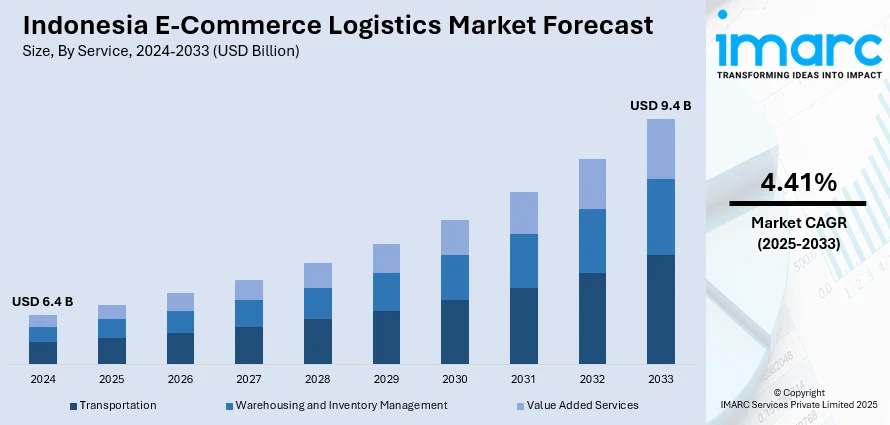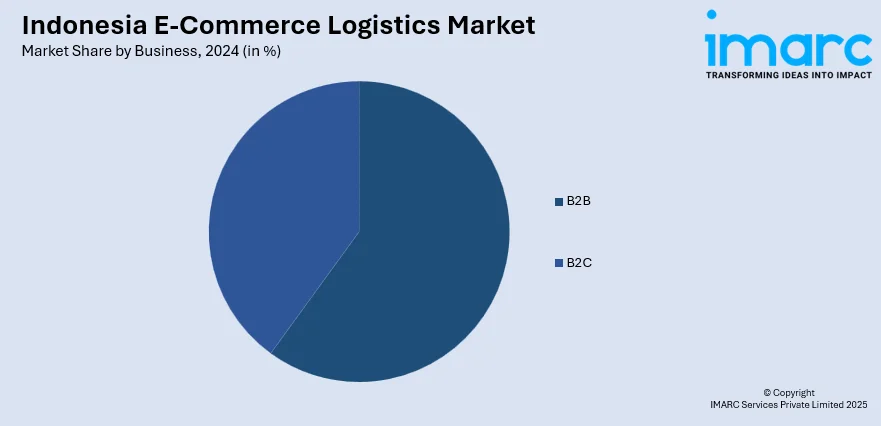
Indonesia E-Commerce Logistics Market Size, Share, Trends and Forecast by Service, Business, Destination, Product, and Region, 2025-2033
Market Overview:
Indonesia e-commerce logistics market size reached USD 6.4 Billion in 2024. Looking forward, IMARC Group expects the market to reach USD 9.4 Billion by 2033, exhibiting a growth rate (CAGR) of 4.41% during 2025-2033. The growing need for efficient international logistics solutions, increasing focus on optimizing delivery routes and reducing packaging waste, and rising adoption of eco-friendly logistics practices and green transportation options represent some of the key factors driving the market.
|
Report Attribute
|
Key Statistics
|
|---|---|
|
Base Year
|
2024 |
|
Forecast Years
|
2025-2033
|
|
Historical Years
|
2019-2024
|
| Market Size in 2024 | USD 6.4 Billion |
| Market Forecast in 2033 | USD 9.4 Billion |
| Market Growth Rate (2025-2033) | 4.41% |
E-commerce logistics facilitates the flow of products, goods, and inventory in online retail. It comprises various critical aspects, such as order fulfillment, inventory management, warehousing, transportation, and last-mile delivery. It also involves numerous activities required to ensure that products ordered online are efficiently and effectively delivered in optimal condition. It is flexible and can adapt to fluctuations in demand and allows businesses to expand without major disruptions. It not only includes the physical movement of products but also the seamless coordination of information and resources. It has inventory management tools that help organizations track stock levels in real time, prevent overstocking or stockouts, and reduce the risk of lost sales and excess holding costs. It streamlines the process of order fulfillment, ranging from receiving an order to packing and shipping the product. It allows companies to reach a broader consumer base, including those in remote or distant locations. It provides improved inventory management, reduced transportation expenses, and minimized order processing costs. As it assists in lowering the chances of errors in order fulfillment, such as shipping the wrong product or delivering to the wrong address, the demand for e-commerce logistics is rising in Indonesia.

To get more information on this market, Request Sample
Indonesia E-Commerce Logistics Market Trends:
At present, the growing demand for e-commerce logistics systems, as they generate valuable data and analytics that can be used to optimize operations and help in demand forecasting, route optimization, and customer behavior analysis, represents one of the major factors influencing the market positively in Indonesia. Moreover, the rising focus on optimizing delivery routes and reducing packaging waste is strengthening the market growth in the country. Apart from this, the escalating demand for e-commerce logistics on account of the increasing adoption of online shopping among individuals is offering a favorable market outlook in Indonesia. Additionally, the wide availability of secure and convenient online payment solutions is providing lucrative growth opportunities to industry investors in Indonesia. In line with this, the increasing need for efficient international logistics solutions, including customs clearance and international shipping, is impelling the market growth. In addition, there is a rise in the demand for faster delivery options, including same-day and next-day delivery. This, coupled with the increasing adoption of eco-friendly logistics practices and green transportation options, is contributing to the market growth in the country. Besides this, the rising number of logistics infrastructures, including warehouses and transportation networks, to enhance the efficiency of e-commerce logistics is bolstering the market growth in Indonesia.
Indonesia E-Commerce Logistics Market Segmentation:
IMARC Group provides an analysis of the key trends in each segment of the market, along with forecasts at the country level for 2025-2033. Our report has categorized the market based on service, business, destination, and product.
Service Insights:
- Transportation
- Warehousing and Inventory Management
- Value Added Services
The report has provided a detailed breakup and analysis of the market based on the service. This includes transportation, warehousing and inventory management, and value added services.
Business Insights:

- B2B
- B2C
A detailed breakup and analysis of the market based on the business have also been provided in the report. This includes B2B and B2C.
Destination Insights:
- Domestic
- International/Cross-border
The report has provided a detailed breakup and analysis of the market based on the destination. This includes domestic and international/cross-border.
Product Insights:
- Fashion and Apparel
- Consumer Electronics
- Home Appliances
- Furniture
- Beauty and Personal Care Products
- Others
A detailed breakup and analysis of the market based on the product have also been provided in the report. This includes fashion and apparel, consumer electronics, home appliances, furniture, beauty and personal care products, and others.
Regional Insights:
- Java
- Sumatra
- Kalimantan
- Sulawesi
- Others
The report has also provided a comprehensive analysis of all the major regional markets, which include Java, Sumatra, Kalimantan, Sulawesi, and Others.
Competitive Landscape:
The market research report has also provided a comprehensive analysis of the competitive landscape in the market. Competitive analysis such as market structure, key player positioning, top winning strategies, competitive dashboard, and company evaluation quadrant has been covered in the report. Also, detailed profiles of all major companies have been provided.
Indonesia E-Commerce Logistics Market Report Coverage:
| Report Features | Details |
|---|---|
| Base Year of the Analysis | 2024 |
| Historical Period | 2019-2024 |
| Forecast Period | 2025-2033 |
| Units | Billion USD |
| Scope of the Report | Exploration of Historical and Forecast Trends, Industry Catalysts and Challenges, Segment-Wise Historical and Predictive Market Assessment:
|
| Services Covered | Transportation, Warehousing and Inventory Management, Value Added Services |
| Business Covered | B2B, B2C |
| Destinations Covered | Domestic, International/Cross-border |
| Products Covered | Fashion and Apparel, Consumer Electronics, Home Appliances, Furniture, Beauty and Personal Care Products, Others |
| Regions Covered | Java, Sumatra, Kalimantan, Sulawesi, Others |
| Customization Scope | 10% Free Customization |
| Post-Sale Analyst Support | 10-12 Weeks |
| Delivery Format | PDF and Excel through Email (We can also provide the editable version of the report in PPT/Word format on special request) |
Key Benefits for Stakeholders:
- IMARC’s industry report offers a comprehensive quantitative analysis of various market segments, historical and current market trends, market forecasts, and dynamics of the Indonesia e-commerce logistics market from 2019-2033.
- The research report provides the latest information on the market drivers, challenges, and opportunities in the Indonesia e-commerce logistics market.
- Porter's five forces analysis assist stakeholders in assessing the impact of new entrants, competitive rivalry, supplier power, buyer power, and the threat of substitution. It helps stakeholders to analyze the level of competition within the Indonesia e-commerce logistics industry and its attractiveness.
- Competitive landscape allows stakeholders to understand their competitive environment and provides an insight into the current positions of key players in the market.
Key Questions Answered in This Report
The e-commerce logistics market in Indonesia was valued at USD 6.4 Billion in 2024.
The Indonesia e-commerce logistics market is projected to exhibit a CAGR of 4.41% during 2025-2033, reaching a value of USD 9.4 Billion by 2033.
The market is driven by booming online retail, rising order volumes from remote regions, and the need for faster last-mile delivery. Logistics players are optimizing routes, integrating tracking systems, and investing in fulfillment centers. Consumer expectations for quicker shipping and return handling are reshaping service models. Flexible delivery options and localized hubs are becoming key differentiators.
Need more help?
- Speak to our experienced analysts for insights on the current market scenarios.
- Include additional segments and countries to customize the report as per your requirement.
- Gain an unparalleled competitive advantage in your domain by understanding how to utilize the report and positively impacting your operations and revenue.
- For further assistance, please connect with our analysts.
 Request Customization
Request Customization
 Speak to an Analyst
Speak to an Analyst
 Request Brochure
Request Brochure
 Inquire Before Buying
Inquire Before Buying




.webp)




.webp)












